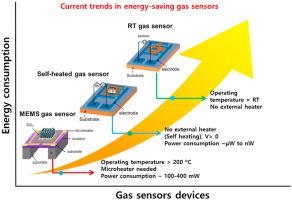Nano Energy ( IF 17.6 ) Pub Date : 2020-09-17 , DOI: 10.1016/j.nanoen.2020.105369 Sanjit Manohar Majhi 1, 2 , Ali Mirzaei 3 , Hyoun Woo Kim 1, 2 , Sang Sub Kim 4 , Tae Whan Kim 5

|
With the tremendous advances in technology, gas-sensing devices are being popularly used in many distinct areas, including indoor environments, industries, aviation, and detectors for various toxic domestic gases and vapors. Even though the most popular type of gas sensor, namely, resistive-based gas sensors, have many advantages over other types of gas sensors, their high working temperatures lead to high energy consumption, thereby limiting their practical applications, especially in mobile and portable devices. As possible ways to deal with the high-power consumption of resistance-based sensors, different strategies such as self-heating, MEMS technology, and room-temperature operation using especial morphologies, have been introduced in recent years. In this review, we discuss different types of energy-saving chemisresitive gas sensors including self-heated gas sensors, MEMS based gas sensors, room temperature operated flexible/wearable sensor and their application in the fields of environmental monitoring. At the end, the review will be concluded by providing a summary, challenges, recent trends, and future perspectives.
中文翻译:

节能化学电阻气体传感器的最新进展:综述。
随着技术的巨大进步,气体传感设备正广泛应用于许多不同的领域,包括室内环境、工业、航空以及各种有毒室内气体和蒸汽的探测器。尽管最流行的气体传感器类型,即基于电阻的气体传感器,与其他类型的气体传感器相比具有许多优点,但它们的高工作温度导致高能量消耗,从而限制了它们的实际应用,特别是在移动和便携式设备中. 作为处理电阻式传感器高功耗的可能方法,近年来引入了自加热、MEMS 技术和使用特殊形态的室温操作等不同策略。在这篇评论中,我们讨论了不同类型的节能化学电阻气体传感器,包括自加热气体传感器、基于 MEMS 的气体传感器、室温操作的柔性/可穿戴传感器及其在环境监测领域的应用。最后,将通过提供总结、挑战、近期趋势和未来前景来总结审查。



























 京公网安备 11010802027423号
京公网安备 11010802027423号